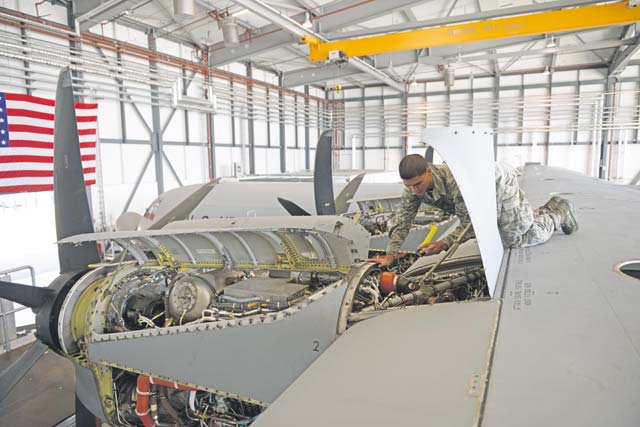
Senior Airman Michael Marquez, 86th Maintenance Squadron crew chief, inspects a C-130J Super Hercules inside and out for any visible mechanical defects.
The 86th Maintenance Group accomplishes all aspects of aircraft equipment maintenance to fulfill the 86th Airlift Wing’s airlift, contingency and support missions. They also provide back shop maintenance and ground support for Air Mobility Command, U.S. European Command and U.S. Central Command assets.
“We are very much linked into the mission to generate combat air power, primarily with the C-130J Super Hercules,” said Col. Raymond Briggs, 86th MXG commander. “However, we also provide the oversight and hosting for four other airframes. Without maintenance, none of those associated missions across any of the five airplanes would get in the air.”
 The 86th MXG comprises two squadrons: the 86th Aircraft Maintenance Squadron and the 86th Maintenance Squadron. The 86th AMXS handles maintenance of the C-130s, and the 86th MXS performs all of the maintenance work done in the shop as well as some maintenance on the airplanes.
The 86th MXG comprises two squadrons: the 86th Aircraft Maintenance Squadron and the 86th Maintenance Squadron. The 86th AMXS handles maintenance of the C-130s, and the 86th MXS performs all of the maintenance work done in the shop as well as some maintenance on the airplanes.
“I think we have some of the best Airmen in the Air Force,” Briggs said. “On the 86th AMXS side, there are Airmen who were trained by Boeing to become flying crew chiefs on the C-40; these are very elite mechanics. While all the additional support falls under the 86th MXS, from sheet metal and metals technology, to conducting letter checks, the highest level inspection performed on the C-130, they do it all.”
Letter checks are in-depth inspections performed every 270 days on the C-130s assigned to Ramstein to secure the longevity of the airframes.
“During a letter check, the C-130s are taken off the flightline and dissembled to be scrutinized,” Briggs said. “The process can take one, two or three weeks depending on what’s being checked, but once it’s done, the airframe is put back on the flightline once again ready to accomplish the mission.”
To ensure that mission gets done, the 86th MXG works closely with the 86th Operations Group.
“Maintenance and operators have a very special relationship more so than with other groups,” Briggs said. “Neither of us can accomplish the mission without the other. Even if we never fly the airplane and are just put on alert, there is a crew. An airplane without a crew is just a nice looking pile of aluminum.”
Briggs said there are three separate, yet intertwined, components that make a mission happen. There needs to be a reason for the mission to happen, the airplane must be ready to go and there needs to be an aircrew.
“They all have to come together, being totally mission ready, configured and properly scheduled at the exact same time,” Briggs said. “The only way we can do that is with a complete partnership between the OG and our Air Mobility Division.”
Though there are maintenance groups around the world, Briggs said Ramstein is the most coveted assignment for maintainers.
“I think I have the greatest job in the Air Force here,” he said. “Our mission is great, we have great people and we get to see the impact of what we do. Almost 40 percent of people who volunteer for Korea want to choose Ramstein as their follow on. They are willing to be away from their families for a year just to come here. That’s how amazing Ramstein is for us.
“Airlift brings a quiet diplomacy. Whether we are moving an African strike force to engage some rebels or we are transporting medicine to the sick, our people get to see the good they are doing in the world (and) all the lives they are impacting,” Briggs continued. “Without the maintainers, none of this would be possible, that’s why I feel we have the best job in the Air Force.”


